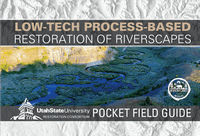Restore Healthy Riverscapes with Low-Tech Process-Based Restoration

Practical, low-tech tools and training to repair degraded riverscapes using natural processes.
Low-Tech Process-Based Restoration of Riverscapes (LTPBR) is one flavor of process-based restoraton aimed at recovering riverscape health. The "low-tech" part refers to the use of simple, hand-built, non-mechanized forms of labor and practices (e.g. building structures, feeding wood or sediment, changing grazing management). The more important part is the process-based restoration (PBR), which is the intention for invoking the processes that ultimately restore health. Most PBR (whether low-tech, assisted with mechanized equipment, or hybrids) works best when the pathway is clearly identified to transition from initial mimicing and promoting of natural processes to a situation where those natural processes necessary for a healthy riverscape are self sustaining.
These resources are maintained by the Utah State University Restoration Consortium with support from the Riverscapes Consortium.
Free Resources
The design manual and Pocket Guide are available digitally for free thanks to the generous investments and support from our sponsors.
LPTBR Design Manual
Comprehensive, free design manual for implementing low-tech process-based restoration
LTPBR Learning Modules
Free, self-paced learning modules on LTPBR concepts and tools
Take a Virtual Reading Riverscapes Field Trip
Learn how to read a riverscape on the ground

Pocket Guide
Condensed, cliff notes version of the manual for field use

Riverscapes Consortium
Free tools, models, and community for riverscape science and restoration
PBR Explorer
Share and discover process-based restoration projects worldwide
Training
We offer courses open to the public through Utah State University (USU), designed for professionals, practitioners, and students working to understand, manage, and restore healthy riverscapes. Gain professional continuing education credits (CEUs) or graduate-level university credit. Open to professionals and students worldwide.
Intro to LTPBR series is offered in the spring. 10-hour, online courses go deep on the what and why of LTPBR. The modular series offers flexibility – take one course or build foundational competency across all six.
Advanced LTPBR Series is for all students looking to go deeper on the how and technical. This series requires the intro series of classes as prerequisites.
Fluvial Geomorphology: Reading Riverscapes is a semester-long course offered in the spring in an online, asynchronous format. This course introduces the fundamentals of fluvial geomorphology through the lens of reading landscapes and riverscapes. It’s ideal for professionals seeking an introduction to fluvial geomorphology.
Register for Spring 2026 Courses
Take for University Credit or Professional CEU credit.
